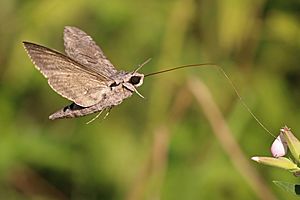Wing coupling facts for kids
Wing coupling is common in some four-winged insects such as moths. It makes them "functionally dipterous". They are effectively two-winged. The advantage is more efficient flight.
In many moths the wing coupling is done by a tiny hook going round a tiny spur. In butterflies and some moths the wing coupling is got by wing overlap, rather than hooks.
Sphingid moths have been much studied for their flying ability, especially their ability to move rapidly from side to side while hovering, called "swing-hovering" or "side-slipping". This is thought to have evolved to deal with ambush predators that lie in wait in flowers.
Images for kids

All content from Kiddle encyclopedia articles (including the article images and facts) can be freely used under Attribution-ShareAlike license, unless stated otherwise. Cite this article:
Wing coupling Facts for Kids. Kiddle Encyclopedia.

